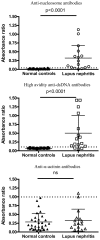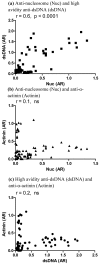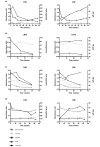Relationship between anti-dsDNA, anti-nucleosome and anti-alpha-actinin antibodies and markers of renal disease in patients with lupus nephritis: a prospective longitudinal study
- PMID: 19828047
- PMCID: PMC2787270
- DOI: 10.1186/ar2831
Relationship between anti-dsDNA, anti-nucleosome and anti-alpha-actinin antibodies and markers of renal disease in patients with lupus nephritis: a prospective longitudinal study
Abstract
Introduction: Glomerulonephritis is a major cause of morbidity and mortality in patients with systemic lupus erythematosus (SLE). Deposition of autoantibodies in the glomeruli plays a key role in the development of lupus nephritis (LN). Different groups have proposed that either anti-nucleosome antibodies or antibodies that bind the intrinsic renal antigen, alpha-actinin, are central to the pathogenesis of LN. These theories have been based mainly on cross-sectional studies in patients and on experiments in animal models. No previous longitudinal studies have compared the relationships between levels of these antibodies and markers of renal function. We assessed how well anti-alpha-actinin, anti-nucleosome and anti-double-stranded DNA (anti-dsDNA) antibodies reflected renal outcome measures in patients with new-onset LN followed for up to 2 years.
Methods: Renal disease activity was monitored by measuring urine protein/creatinine ratio (PCR), serum albumin and a composite outcome of renal remission. At each time point, anti-nucleosome and anti-alpha-actinin antibodies were measured by enzyme-linked immunosorbent assay. High-avidity anti-dsDNA antibodies were measured using the Farrzyme assay. We analysed relationships between levels of the three antibodies and between antibody levels and renal outcome measures over time.
Results: Levels of anti-nucleosome and anti-dsDNA were positively correlated with each other (r = 0.6, P = 0.0001) but neither correlated with anti-alpha-actinin level. At baseline, mean anti-nucleosome levels were higher in patients with LN than in healthy controls (0.32 versus 0.01, P < 0.001). The same was true for anti-dsDNA antibodies (0.50 versus 0.07, P < 0.001) but not for anti-alpha-actinin (0.33 versus 0.29). Over the follow-up period, anti-nucleosome and anti-dsDNA levels associated positively with urine PCR (P = 0.041 and 0.051, respectively) and negatively with serum albumin (P = 0.027 and 0.032, respectively). Both anti-nucleosome and anti-dsDNA levels were significantly lower during renal remission than when renal disease was active (P = 0.002 and 0.003, respectively). However, there was no relationship between anti-alpha-actinin levels and urine PCR, serum albumin or remission status.
Conclusions: This prospective longitudinal clinical study is the first to compare levels of anti-nucleosome, anti-dsDNA and anti-alpha-actinin antibodies in the same patients with SLE. Our results support the concept that, in the majority of patients, anti-nucleosome antibodies play a major role in pathogenesis of LN, in contrast to anti-alpha-actinin antibodies.
Figures



References
-
- Cervera R, Khamashta MA, Font J, Sebastiani GD, Gil A, Lavilla P, Mejía JC, Aydintug AO, Chwalinska-Sadowska H, de Ramón E, Fernández-Nebro A, Galeazzi M, Valen M, Mathieu A, Houssiau F, Caro N, Alba P, Ramos-Casals M, Ingelmo M, Hughes GR. European Working Party on Systemic Lupus Erythematosus. Morbidity and mortality in systemic lupus erythematosus during a 10-year period: a comparison of early and late manifestations in a cohort of 1,000 patients. Medicine (Baltimore) 2003;82:299–308. doi: 10.1097/01.md.0000091181.93122.55. - DOI - PubMed
-
- ter Borg EJ, Horst G, Hummel EJ, Limburg PC, Kallenberg CG. Measurement of increases in anti-double-stranded DNA antibody levels as a predictor of disease exacerbation in systemic lupus erythematosus. A long-term, prospective study. Arthritis Rheum. 1990;33:634–643. doi: 10.1002/art.1780330505. - DOI - PubMed
-
- Winfield JB, Faiferman I, Koffler D. Avidity of anti-DNA antibodies in serum and IgG glomerular eluates from patients with systemic lupus erythematosus. Association of high avidity antinative DNA antibody with glomerulonephritis. J Clin Invest. 1977;59:90–96. doi: 10.1172/JCI108626. - DOI - PMC - PubMed
Publication types
MeSH terms
Substances
Grants and funding
LinkOut - more resources
Full Text Sources

